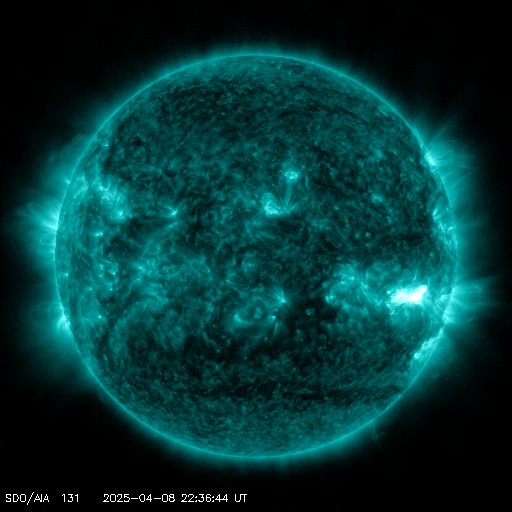Viewing archive of Sunday, 15 May 2005
Solar activity report
# Prepared jointly by the U.S. Dept. of Commerce, NOAA, #Space Environment Center and the U.S. Air Force. #
Joint USAF/NOAA Report of Solar and Geophysical Activity
SDF Number 135 Issued at 2200Z on 15 May 2005IA. Analysis of Solar Active Regions and Activity from 14-2100Z to 15-2100Z
IB. Solar Activity Forecast
IIA. Geophysical Activity Summary 14-2100Z to 15-2100Z
IIB. Geophysical Activity Forecast
III. Event Probabilities 16 May to 18 May
| Class M | 40% | 35% | 30% |
| Class X | 05% | 05% | 05% |
| Proton | 40% | 10% | 05% |
| PCAF | yellow | ||
IV. Penticton 10.7 cm Flux
Observed 15 May 103 Predicted 16 May-18 May 100/100/100 90 Day Mean 15 May 093
V. Geomagnetic A Indices
Observed Afr/Ap 14 May 004/008 Estimated Afr/Ap 15 May 075/100 Predicted Afr/Ap 16 May-18 May 020/040-012/015-008/010
VI. Geomagnetic Activity Probabilities 16 May to 18 May
| A. Middle Latitudes | |||
|---|---|---|---|
| Active | 30% | 25% | 20% |
| Minor storm | 25% | 10% | 10% |
| Major-severe storm | 15% | 01% | 01% |
| B. High Latitudes | |||
|---|---|---|---|
| Active | 25% | 25% | 20% |
| Minor storm | 30% | 15% | 10% |
| Major-severe storm | 25% | 05% | 01% |
All times in UTC
Current data suggests there is a moderate possibility for aurora to appear at the following high latitude regions in the near future
ReykjavikCurrent data suggests there is a slight possibility for aurora to appear at the following high latitude regions in the near future
TórshavnOulu
Trondheim
Luleå, Sundsvall, Umeå
Latest news
Latest forum messages
Support SpaceWeatherLive.com!
A lot of people come to SpaceWeatherLive to follow the Sun's activity or if there is aurora to be seen, but with more traffic comes higher server costs. Consider a donation if you enjoy SpaceWeatherLive so we can keep the website online!

Latest alerts
Tuesday, 8 April 2025
23:57 UTC - Hemispheric Power Index
The OVATION model predicts the Hemispheric Power Index to reach 50GW at 00:44 UTC
22:42 UTC - Solar flare
Moderate M1.57 flare
22:24 UTC - Radio Blackout
Minor R1 radio blackout in progress (≥M1 - current: M1.52)
15:15 UTC - Geomagnetic activity
Minor G1 geomagnetic storm (Kp5) Threshold Reached: 14:59 UTC
06:30 UTC - Type II Radio Emission
Begin Time: 08/04/2025 05:53 UTC Estimated Velocity: 456km/sec.
Space weather facts
| Last X-flare | 2025/03/28 | X1.1 |
| Last M-flare | 2025/04/08 | M1.5 |
| Last geomagnetic storm | 2025/04/06 | Kp5 (G1) |
| Spotless days | |
|---|---|
| Last spotless day | 2022/06/08 |
| Monthly mean Sunspot Number | |
|---|---|
| March 2025 | 134.2 -20.4 |
| April 2025 | 151.3 +17.1 |
| Last 30 days | 137.4 +0.1 |




